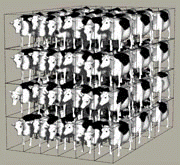Animal Science, Department of

World Congress on Genetics Applied to Livestock Production: 3rd (1986)
Date of this Version
1986
Abstract
Milk recording, artificial insemination and computers have given the dairy cattle industry and effective combination of tools for genetic improvement. Selection theory (Robertson and Rendel, 1950) indicates that annual gains of 1.5 to 2.0% of the mean should be possible.
The dairy industry is also fortunate that one trait, milk production (used as a general term for yield of milk, fat and protein), is of primary importance. Another advantage is that no intermediate optimum for milk production is obvious--more and more seems to be profitable--in contrast to the situation for most traits of most livestock.
With these advantages for making genetic gain, evaluation of dairy cattle breeding programs would seem simple; compare gain that has occurred with theoretical gain. Most estimates of genetic gain have been for mild production records. The theme of the following pages will be to review a few recent estimates of genetic gain and to review three factors that may contribute to the failure of actual gain to equal theoretical gain. These factors are generation interval, emphasis on traits other than milk production, and weaknesses in genetic evaluations of bulls and cows.


Comments
Published in 3rd World Congress on Genetics Applied to Livestock Production, edited by Gordon E. Dickerson and Rodger K. Johnson, 4 vols. (Lincoln: University of Nebraska Institute of Agriculture and Natural Resources, 1986). Copyright © 1986 Board of Regents University of Nebraska.